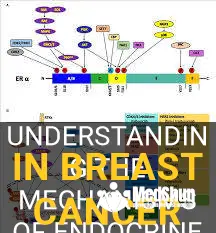
Breast cancer is one of the most common types of cancer in women, and while significant progress has been made in its treatment, a major challenge that remains is the development of endocrine resistance. Endocrine resistance refers to the phenomenon where breast cancer cells no longer respond to hormonal therapies, such as tamoxifen or aromatase inhibitors, making the treatment significantly less effective. This resistance poses a significant hurdle in the battle against breast cancer, as it can lead to disease progression and decreased patient survival rates. Researchers and scientists are actively investigating the underlying mechanisms of endocrine resistance in order to develop novel strategies to overcome this challenge and improve outcomes for breast cancer patients.
| Characteristics | Values |
|---|---|
| Disease stage | Advanced breast cancer |
| ER (estrogen receptor) status | Positive or negative |
| PR (progesterone receptor) status | Positive or negative |
| HER2 (human epidermal growth factor receptor 2) status | Positive or negative |
| Ki-67 proliferation index | High or low |
| Tumor grade | High or low |
| Molecular subtype | Luminal A, Luminal B, HER2-enriched, or Triple-negative |
| Previous hormone therapy | Yes or no |
| Duration of previous hormone therapy | Short or long |
| Resistance mechanism | Acquired or de novo |
| Activation of alternative signaling pathways | Yes or no |
| Crosstalk between signaling pathways | Yes or no |
| Overexpression of specific genes or proteins | Yes or no |
| Loss of tumor suppressor genes | Yes or no |
| Epigenetic modifications | Yes or no |
| Microenvironment alterations | Yes or no |
What You'll Learn
- What are the potential causes of endocrine resistance in breast cancer treatment?
- How does endocrine resistance impact the effectiveness of hormone therapies?
- Are there any known genetic factors that contribute to endocrine resistance in breast cancer?
- What strategies are being developed to overcome or prevent endocrine resistance in breast cancer treatment?
- How can patients and healthcare providers effectively manage endocrine resistance to ensure optimal outcomes in breast cancer treatment?

What are the potential causes of endocrine resistance in breast cancer treatment?
Breast cancer is a highly heterogeneous disease, and there are various subtypes with different molecular characteristics. One major subtype of breast cancer is estrogen receptor-positive (ER+) breast cancer, which accounts for around 70% of all breast cancer cases. Endocrine therapy, such as tamoxifen or aromatase inhibitors, is the standard treatment for ER+ breast cancer. However, not all patients respond favorably to endocrine therapy, and some develop resistance over time. Understanding the potential causes of endocrine resistance is crucial for developing effective treatment strategies.
- Mutations in the estrogen receptor (ER): One of the primary mechanisms of endocrine resistance is the acquisition of mutations in the ER gene. These mutations can alter the structure and function of the ER protein, leading to reduced binding affinity for endocrine agents. Mutations in the ER gene have been identified in a subset of patients who develop resistance to aromatase inhibitors. Understanding the specific mutations and their impact on endocrine response is essential for devising targeted therapies.
- Activation of alternative signaling pathways: Breast cancer cells have the ability to activate alternative signaling pathways to bypass the inhibitory effects of endocrine therapy. For example, activation of the PI3K/AKT/mTOR signaling pathway can lead to resistance to endocrine agents. This pathway is involved in cell growth and survival and can promote cell proliferation even in the presence of endocrine therapy. Combining endocrine therapy with inhibitors of the PI3K/AKT/mTOR pathway has shown promise in overcoming resistance.
- Loss of ER expression: In some cases, breast cancer cells can lose ER expression, rendering endocrine therapy less effective. This loss of ER expression can occur through various mechanisms, including genetic alterations, epigenetic modifications, and clonal selection. Loss of ER expression is often associated with more aggressive tumor behavior and resistance to endocrine therapy. Strategies to restore ER expression or target alternative pathways in ER-negative breast cancer are currently being investigated.
- Tumor microenvironment: The role of the tumor microenvironment in endocrine resistance is increasingly recognized. Various components of the tumor microenvironment, such as cancer-associated fibroblasts and immune cells, can promote endocrine resistance through the secretion of cytokines and growth factors. Additionally, hypoxia, which is commonly observed in tumors, can induce resistance to endocrine therapy. Targeting the tumor microenvironment may represent a novel approach to overcome endocrine resistance.
- Epigenetic changes: Epigenetic modifications, such as DNA methylation and histone modifications, can influence gene expression and contribute to endocrine resistance. Alterations in the epigenome can result in the silencing of tumor suppressor genes or the activation of oncogenes, leading to resistance to endocrine therapy. Understanding the epigenetic changes associated with endocrine resistance may provide new opportunities for therapeutic intervention.
In conclusion, endocrine resistance in breast cancer is a complex phenomenon with multiple potential causes. Mutations in the ER gene, activation of alternative signaling pathways, loss of ER expression, tumor microenvironment factors, and epigenetic changes all contribute to endocrine resistance. Further research is needed to elucidate the underlying mechanisms and develop targeted therapies to overcome endocrine resistance in breast cancer.
The Best Treatment Options for Metastatic Breast Cancer
You may want to see also

How does endocrine resistance impact the effectiveness of hormone therapies?
Endocrine resistance is a phenomenon that occurs when cancer cells become resistant to hormone therapies, which are commonly used to treat hormone receptor-positive breast and prostate cancers. Hormone therapy works by blocking the production of hormones or interfering with their action, thereby preventing the growth and spread of hormone-dependent tumors. However, over time, cancer cells can develop mechanisms to bypass or counteract the effects of hormone therapy, rendering it ineffective.
There are several mechanisms by which cancer cells can develop endocrine resistance. One of the most common mechanisms is the upregulation of alternative signaling pathways. For example, in breast cancer, the activation of growth factor receptors such as HER2 can bypass the need for hormone receptors for cell growth and survival. Similarly, in prostate cancer, the activation of the androgen receptor signaling pathway, even in the absence of androgens, can drive tumor growth.
Another mechanism of endocrine resistance is the alteration of hormone receptors themselves. Cancer cells can acquire mutations in the hormone receptors, either the estrogen receptor (ER) in breast cancer or the androgen receptor (AR) in prostate cancer, which render them less responsive to hormone therapy. These mutations can lead to changes in the conformation or function of the receptors, resulting in reduced binding of hormone therapies or altered downstream signaling.
Additionally, cancer cells can develop mechanisms to increase the production or utilization of hormones. For example, in breast cancer, the aromatase enzyme, which is responsible for converting androgens to estrogens, can be upregulated, leading to increased estrogen levels despite hormone therapy. Similarly, in prostate cancer, the tumor microenvironment can produce androgens or activate alternative pathways to maintain androgen receptor signaling even in the absence of circulating androgens.
Endocrine resistance can have a significant impact on the effectiveness of hormone therapies. When cancer cells become resistant to hormone therapies, the tumors can resume growth and spread, leading to disease progression. This can result in the need for additional treatments, such as chemotherapy or targeted therapies, which may have more severe side effects or limited efficacy compared to hormone therapy.
To overcome endocrine resistance, researchers are exploring various strategies. One approach is to develop new hormone therapies that target alternative signaling pathways or bypass the mutated hormone receptors. For example, in breast cancer, drugs that target HER2 receptors, such as trastuzumab, have shown efficacy in patients who have developed resistance to hormone therapy. In prostate cancer, second-generation androgen receptor inhibitors, such as enzalutamide and abiraterone, have been developed to target the altered androgen receptor signaling.
Another approach is to combine hormone therapies with other drugs that can block or inhibit the mechanisms of endocrine resistance. For example, in breast cancer, the combination of hormone therapy with CDK4/6 inhibitors, which block cell cycle progression, has shown improved outcomes in clinical trials. Similarly, in prostate cancer, combining androgen deprivation therapy with agents that target the tumor microenvironment, such as angiogenesis inhibitors or immunotherapies, is being explored.
In conclusion, endocrine resistance is a complex phenomenon that can significantly impact the effectiveness of hormone therapies in the treatment of hormone receptor-positive cancers. Understanding the mechanisms underlying endocrine resistance and developing strategies to overcome it is crucial for improving patient outcomes and preventing disease progression. Ongoing research in this area holds promise for the development of new treatment approaches and improved personalized therapy for patients with endocrine-resistant cancers.
Understanding the effects of breast cancer treatment on the delicate balance of glands in the body
You may want to see also

Are there any known genetic factors that contribute to endocrine resistance in breast cancer?
Endocrine resistance is a major challenge in the treatment of breast cancer. While endocrine therapies have proven to be effective in many cases, a significant proportion of patients develop resistance to these treatments. The mechanisms underlying endocrine resistance are complex and multifaceted, involving both genetic and non-genetic factors. In recent years, there has been increasing evidence to suggest that genetic factors play a significant role in the development of endocrine resistance in breast cancer.
Several studies have identified specific genetic alterations that are associated with endocrine resistance. One such alteration is the mutation in the ESR1 gene, which codes for the estrogen receptor, the primary target of endocrine therapies. Mutations in this gene have been found to be more common in patients who have developed resistance to endocrine therapies. These mutations can alter the structure and function of the estrogen receptor, leading to reduced sensitivity to hormone-based treatments.
Another genetic factor that has been implicated in endocrine resistance is the overexpression of the cyclin D1 gene. Cyclin D1 is a protein that regulates cell cycle progression and is often overexpressed in breast cancer. Studies have shown that high levels of cyclin D1 are associated with resistance to endocrine therapies, suggesting that this genetic alteration may contribute to treatment failure.
In addition to these specific genetic alterations, there is also evidence to suggest that genetic variations in drug metabolizing enzymes and transporters may influence endocrine resistance. For example, genetic variations in the CYP3A gene, which is involved in the metabolism of endocrine drugs, have been shown to affect treatment response. Similarly, variations in genes encoding drug transporters such as ABCB1 and ABCC1 have been associated with altered drug transport and reduced efficacy of endocrine therapies.
It is worth noting that genetic factors are not the sole determinants of endocrine resistance. Non-genetic factors such as tumor heterogeneity, tumor microenvironment, and epigenetic modifications also play important roles. Moreover, the development of endocrine resistance is often a complex and dynamic process, involving the selection of pre-existing resistant clones, as well as the acquisition of new genetic alterations during treatment.
Understanding the genetic factors that contribute to endocrine resistance is crucial for the development of novel treatment strategies. Targeting specific genetic alterations, such as ESR1 mutations or cyclin D1 overexpression, may help overcome endocrine resistance and improve patient outcomes. Additionally, identifying genetic variants that affect drug metabolism and transport may enable personalized treatment approaches, tailored to individual patients' genetic profiles.
In conclusion, there is growing evidence to suggest that genetic factors play a significant role in endocrine resistance in breast cancer. Specific genetic alterations in genes such as ESR1 and cyclin D1 have been associated with resistance to endocrine therapies. Genetic variations in drug metabolizing enzymes and transporters may also influence treatment response. However, it is important to note that genetic factors are not the sole determinants of endocrine resistance, and non-genetic factors also contribute to treatment failure. Further research is needed to fully elucidate the complex interplay between genetic and non-genetic factors in endocrine resistance and to develop effective strategies to overcome this challenge.
Understanding the Role of Herceptin in Breast Cancer Treatment
You may want to see also

What strategies are being developed to overcome or prevent endocrine resistance in breast cancer treatment?
Breast cancer is the most common cancer in women worldwide, and endocrine therapy is a standard treatment option for hormone receptor-positive breast cancer. However, a significant challenge in the treatment of breast cancer is the development of endocrine resistance, where the cancer cells stop responding to hormonal therapies.
Understanding the mechanisms behind endocrine resistance is of utmost importance in developing strategies to overcome or prevent it. There are several strategies currently being developed to tackle endocrine resistance in breast cancer treatment. Some of the key approaches include:
- Combination Therapy: Combining endocrine therapy with other targeted therapies or cytotoxic drugs is a promising strategy to overcome resistance. For instance, a combination of endocrine therapy with CDK4/6 inhibitors has shown significant clinical benefit in multiple trials. These inhibitors target proteins involved in cell cycle regulation, and their use in combination with endocrine therapy has demonstrated improved progression-free survival and overall survival in patients with advanced breast cancer.
- Molecular Profiling: Understanding the molecular profile of tumors can help identify specific genetic alterations or biomarkers associated with endocrine resistance. This knowledge can then be used to guide treatment decisions and develop personalized therapies. For example, the identification of mutations in the estrogen receptor gene (ESR1) has led to the development of specific inhibitors that target these mutations and restore sensitivity to endocrine therapy.
- Immunotherapy: The use of immunotherapy in breast cancer is an emerging field, and recent studies have shown promising results. Immune checkpoint inhibitors, such as PD-1 and PD-L1 inhibitors, have demonstrated efficacy in some breast cancer subtypes. Combining immunotherapy with endocrine therapy may help overcome endocrine resistance by enhancing the immune response against cancer cells and preventing immune evasion.
- Targeting Signaling Pathways: Several signaling pathways play a role in endocrine resistance, including the PI3K/AKT/mTOR pathway and the HER2 pathway. Targeted therapies that inhibit these pathways have shown clinical benefit in preclinical and clinical studies. For example, the addition of PI3K inhibitors to endocrine therapy has demonstrated improved outcomes in patients with PIK3CA-mutant tumors.
- Epigenetic Modulation: Epigenetic changes, such as DNA methylation and histone modification, have been implicated in endocrine resistance. Targeting these epigenetic modifications offers a potential strategy to reverse resistance. Several epigenetic modifiers, such as histone deacetylase inhibitors and DNA methyltransferase inhibitors, are currently being investigated in clinical trials for their potential to restore sensitivity to endocrine therapy.
It is worth noting that the development of resistance to one endocrine therapy does not necessarily mean resistance to all endocrine therapies. Switching to a different class of endocrine therapy or combining different endocrine therapies may still be effective in some cases. Additionally, ongoing research is focused on identifying novel targets and biomarkers associated with endocrine resistance to further enhance treatment strategies.
In conclusion, the development of endocrine resistance in breast cancer treatment is a significant challenge. However, several strategies are currently being developed to overcome or prevent this resistance, including combination therapy, molecular profiling, immunotherapy, targeting signaling pathways, and epigenetic modulation. These approaches hold promise in improving outcomes for patients with hormone receptor-positive breast cancer.
Understanding and Managing Breast Cancer Treatment-Induced Rashes
You may want to see also

How can patients and healthcare providers effectively manage endocrine resistance to ensure optimal outcomes in breast cancer treatment?
Introduction:
Breast cancer is the most common cancer among women worldwide, and hormone receptor-positive breast cancer accounts for approximately 75% of all cases. Endocrine therapy, which targets the estrogen receptor pathway, has revolutionized the treatment of hormone receptor-positive breast cancer. However, a significant number of patients eventually develop endocrine resistance, leading to disease progression and poorer outcomes. In this article, we will discuss strategies that patients and healthcare providers can employ to effectively manage endocrine resistance and ensure optimal outcomes in breast cancer treatment.
Understanding endocrine resistance:
Endocrine resistance occurs when breast cancer cells no longer respond to endocrine therapy. There are two primary mechanisms of endocrine resistance: hormone-dependent mechanisms and hormone-independent mechanisms. Hormone-dependent mechanisms involve changes in the estrogen receptor, such as mutations or loss of expression, which render the cancer cells less responsive to endocrine therapy. Hormone-independent mechanisms, on the other hand, involve the activation of alternative signaling pathways that bypass the estrogen receptor and promote cancer cell growth. It is essential for patients and healthcare providers to understand these mechanisms to develop appropriate management strategies.
Regular monitoring and assessment:
Regular monitoring and assessment of treatment response are crucial in managing endocrine resistance. This can be achieved through regular imaging studies, such as mammograms or MRIs, to evaluate tumor size and progression. Additionally, laboratory tests, such as measuring tumor markers like CA 15-3 or CEA, can provide valuable information about treatment response. Consistent monitoring allows healthcare providers to detect endocrine resistance early and modify treatment plans accordingly.
Switching or combining endocrine therapies:
When endocrine resistance is detected, healthcare providers may consider switching or combining different types of endocrine therapies. For example, if a patient initially received tamoxifen, a selective estrogen receptor modulator, and develops endocrine resistance, the healthcare provider may switch to an aromatase inhibitor, such as letrozole or exemestane. Alternatively, combining endocrine therapies, such as adding a CDK4/6 inhibitor to an aromatase inhibitor, has shown promising results in managing endocrine resistance and improving outcomes.
Targeted therapies:
In cases of hormone-independent endocrine resistance, targeted therapies can be employed to inhibit alternative signaling pathways that promote cancer cell growth. For example, mTOR inhibitors, such as everolimus, have been approved for use in combination with endocrine therapy for patients with advanced hormone receptor-positive breast cancer and endocrine resistance. Other targeted therapies, such as PI3K inhibitors or HER2-targeted agents, may also be considered based on the specific molecular characteristics of the tumor.
Clinical trials and personalized medicine:
Participating in clinical trials can provide patients with access to novel therapies and cutting-edge treatments for endocrine resistance. Clinical trials aim to identify new drugs or drug combinations that can overcome endocrine resistance and improve patient outcomes. Additionally, advancements in molecular profiling techniques allow for personalized medicine approaches, where treatment decisions are tailored based on the individual tumor's molecular characteristics. Personalized medicine has the potential to optimize treatment outcomes by selecting therapies that target the specific mechanisms driving endocrine resistance.
Endocrine resistance is a significant challenge in the treatment of hormone receptor-positive breast cancer. However, by understanding the mechanisms of endocrine resistance and employing strategies such as regular monitoring, switching or combining endocrine therapies, targeted therapies, participating in clinical trials, and personalized medicine approaches, patients and healthcare providers can effectively manage endocrine resistance and ensure optimal outcomes in breast cancer treatment. It is essential for patients to have open and ongoing communication with their healthcare providers to discuss treatment options and make informed decisions about their care.
Frequently asked questions
Endocrine resistance refers to the phenomenon when breast cancer becomes resistant to hormonal therapies, such as tamoxifen or aromatase inhibitors, which are commonly used to treat hormone receptor-positive breast cancer. This means that the cancer cells are no longer responsive to these treatments and continue to grow and spread.
The exact cause of endocrine resistance in breast cancer is not fully understood. However, researchers believe that it is often related to changes in the cancer cells themselves. For example, some breast cancer cells may develop genetic mutations or alterations that disrupt the normal pathways and mechanisms through which hormonal therapies work. Other factors, such as the presence of cancer stem cells or alterations in the tumor microenvironment, may also contribute to endocrine resistance.
When breast cancer becomes resistant to hormonal therapies, other treatment options may be considered. One approach is to switch to a different hormonal therapy that targets a different pathway or receptor. For example, if a patient becomes resistant to an aromatase inhibitor, they may be switched to a different aromatase inhibitor or to tamoxifen. In some cases, combination therapies that target multiple pathways or utilize different types of treatments, such as chemotherapy or targeted therapies, may be used. Additionally, ongoing research is dedicated to understanding the mechanisms of endocrine resistance and developing new therapies to overcome it.







